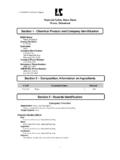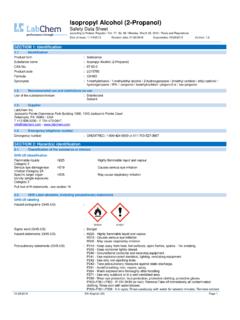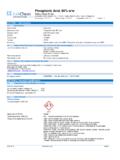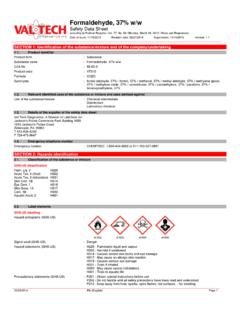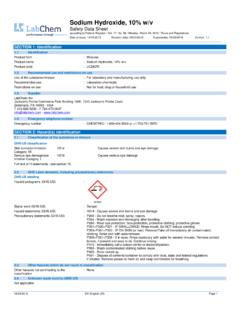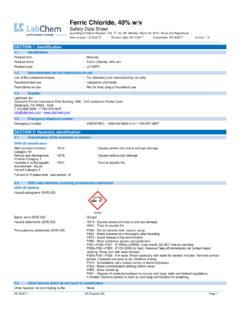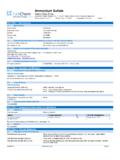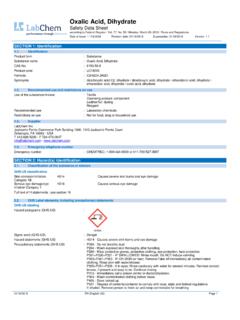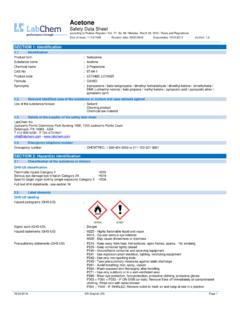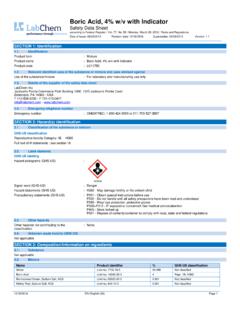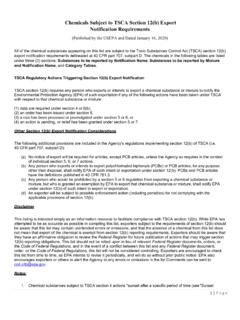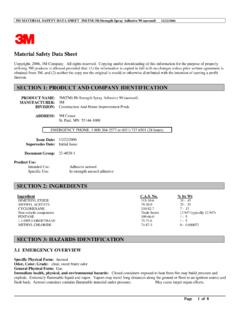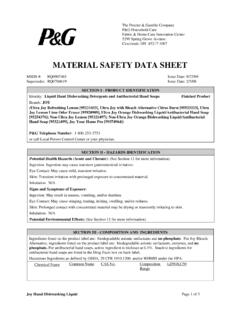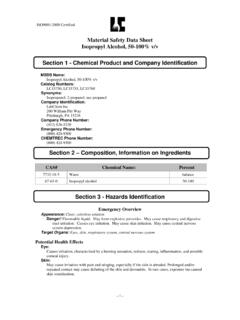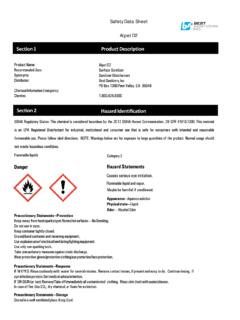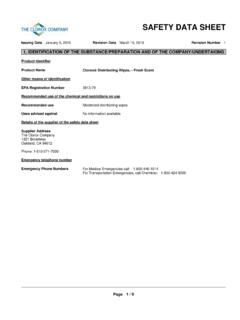Transcription of Material Safety Data Sheet Sodium nitrate
1 Material Safety data SheetSodium nitrate - 1 - section 1 - chemical Product and Company IdentificationMSDS Name: Sodium nitrateCatalog Numbers:LC24650 Synonyms:Cubic niter; Soda niter; Chile saltpeterCompany Identification:LabChem Inc200 William Pitt WayPittsburgh, PA 15238 Company Phone Number:(412) 826-5230 Emergency Phone Number:(800) 424-9300 CHEMTREC Phone Number:(800) 424-9300 section 2 Composition, Information on Ingredients CAS# chemical Name: Percent7631-99-4 Sodium nitrate100 section 3 - Hazards IdentificationEmergency OverviewAppearance: White ! Strong oxidizer. Contact with other Material may cause a fire. Causes eye, skin, andrespiratory tract irritation. Harmful if swallowed. May cause Organs: Blood, respiratory system, eyes, Health EffectsEye:Causes eye :Causes skin :Harmful if swallowed.
2 May cause irritation of the digestive tract. May cause methemoglobinemia,cyanosis (bluish discoloration of skin due to deficient oxygenation of the blood), convulsions, anddeath. Methemoglobinemia is characterized by dizziness, drowsiness, headache, shortness of breath,cyanosis, rapid heart rate and chocolate-brown colored :2000 CertifiedMaterial Safety data SheetSodium nitrate - 2 -Inhalation:Causes respiratory tract irritation. May cause methemoglobinemia, cyanosis, convulsions,tachycardia, dyspnea (labored breathing), and death. The toxicity of nitrates is due to their in-vivoconversion to nitrites, which may lead to : Sodium nitrate may react with secondary or tertiary amines to form nitrosamines (certainnitrosamines are cancer suspect agents). section 4 - First Aid MeasuresEyes:Flush eyes with plenty of water for at least 15 minutes, occasionally lifting the upper and lowereyelids.
3 Get medical :Get medical aid. Flush skin with plenty of water for at least 15 minutes while removingcontaminated clothing and shoes. Wash clothing before :Call a poison control center. If swallowed, do not induce vomiting unless directed to do so bymedical personnel. Never give anything by mouth to an unconscious person. Get medical :Remove from exposure and move to fresh air immediately. If not breathing, give artificialrespiration. If breathing is difficult, give oxygen. Get medical aid. Do NOT use to Physician:Treat symptomatically and 5 - Fire Fighting MeasuresGeneral Information:As in any fire, wear a self-contained breathing apparatus in pressure-demand, MSHA/NIOSH(approved or equivalent), and full protective gear. Strong oxidizer. Contact with other Material maycause fire. Wear appropriate protective clothing to prevent contact with skin and eyes.
4 Wear a self-contained breathing apparatus (SCBA) to prevent contact with thermal decomposition Media:Use water only!Autoignition Temperature:Not Point:Not Rating:Not Limits:Not Safety data SheetSodium nitrate - 3 - section 6 - Accidental Release MeasuresGeneral Information:Use proper personal protective equipment as indicated in section :Vacuum or sweep up Material and place into a suitable disposal container. Clean up spillsimmediately, observing precautions in the Protective Equipment section . Avoid generating dustyconditions. Provide ventilation. Keep combustibles (wood, paper, oil, etc.,) away from 7 - Handling and StorageHandling:Use with adequate ventilation. Minimize dust generation and accumulation. Avoid contact with skinand eyes. Empty containers retain product residue, liquid and vapor, and can be dangerous.
5 Keepcontainer tightly closed. Avoid contact with clothing and other combustible materials. Avoidingestion and inhalation. Use only in a chemical fume hood. Do not pressurize, cut, weld, braze,solder, drill, grind, or expose empty containers to heat, sparks or open :Do not store near combustible materials. Store in a tightly closed container. Store in a cool, dry,well-ventilated area away from incompatible substances. Avoid storage on wood 8 - Exposure Controls, Personal ProtectionEngineering Controls:Facilities storing or utilizing this Material should be equipped with an eyewash facility and a safetyshower. Use adequate ventilation to keep airborne concentrations Limits: chemical Name:ACGIHNIOSHOSHAS odium nitratenone listednone listednone listedOSHA Vacated PELs: Sodium nitrate : No OSHA Vacated PELs are listed for this Protective EquipmentEyes:Wear appropriate protective eyeglasses or chemical Safety goggles as described by OSHA's eye andface protection regulations in 29 CFR or European Standard :Wear appropriate gloves to prevent skin :Wear appropriate protective clothing to prevent skin :Follow the OSHA respirator regulations found in 29 CFR or European Standard EN a NIOSH/MSHA or European Standard EN 149 approved respirator if exposure limits areexceeded or if irritation or other symptoms are Safety data SheetSodium nitrate - 4 - section 9 - Physical and chemical PropertiesPhysical State.
6 CrystalsColor:WhiteOdor: (5% aq. solution)Vapor Pressure:Not availableVapor Density:Not availableEvaporation Rate:Not availableViscosity:Not availableBoiling Point:380 CFreezing/Melting Point:306 CDecomposition Temperature:380 CSolubility in water:SolubleSpecific Gravity/Density:900 g/l (20 C)Molecular Formula:NNaO3 Molecular 10 - Stability and ReactivityChemical Stability:Hygroscopic: absorbs moisture or water from the to Avoid:Incompatible materials, dust generation, excess heat, exposure to moist air or with Other Materials:Organic materials, combustible materials, reducing agents, easily oxidizable materials, finelypowdered metals, fluorine, Decomposition Products:Oxides of nitrogen, Polymerization:Has not been 11 - Toxicological InformationRTECS:CAS# 7631-99-4: WC5600000LD50/LC50:CAS# 7631-99-4:Oral, mouse.
7 LD50 = 3500 mg/kg;Oral, rabbit: LD50 = 2680 mg/kg;Oral, rat: LD50 = 1267 mg/kgCarcinogenicity:CAS# 7631-99-4: Not listed by ACGIH, IARC, NTP, or CA Prop :See actual :No information Safety data SheetSodium nitrate - 5 -Reproductive:Orl-mus TDL0: 16800 mg/kg (14D male)Mutagenicity:Mutagenic effects have occurred in :No information 12 - Ecological InformationEcotoxicity:No data available. This Material will not cause oxygen depletion in aquatic systems. It has a lowpotential to affect aquatic organisms, secondary waste treatment microorganisms, and the growth ofsome plants. It has a moderate potential to affect the germination of some plants. Acute aquaticeffects: 96-hour LC50; Fathead minnow: GT 1000 mg/L 96-hour LC50; Water flea: GT 1000 mg/LEnvironmental:Nitrates are predominantly used as fertilizer.
8 Unfortunately, nitrates have a tendency to migrate intogroundwater as they do not bind to soil and are extremely soluble. Excessive levels of nitrates indrinking water may cause serious illness and death. Infants are most susceptible to nitrate toxicity."Blue Baby Syndrome" can occur when the infant's conversion of nitrate to nitrite interferes with theoxygen-carrying capacity of the blood. Symptoms of Blue Baby Syndrome include, but may not belimited to, shortness of breath and bluish colored :No information :Do not empty into 13 - Disposal ConsiderationsDispose of in accordance with Federal, State, and local 14 - Transport InformationUS DOTS hipping Name: Sodium nitrateHazard Number:UN1498 Packing Group:IIIS ection 15 - Regulatory InformationUS FederalTSCA:CAS# 7631-99-4 is listed on the TSCA Reportable Quantities (RQ):None of the chemicals in this Material have an Safety data SheetSodium nitrate - 6 -CERCLA/SARA section 313:This Material contains Sodium nitrate (listed as Water Dissociable nitrate Compounds), 100%,(CAS# 7631-99-4) which is subject to the reporting requirements of section 313 of SARA TitleIII and 40 CFR Part - Highly Hazardous.
9 None of the chemicals in this product are considered highly hazardous by StateState Right to Know:CAS# 7631-99-4 can be found on the following state right to know lists: New Jersey, Pennsylvania, RegulationsCanadian DSL/NDSL:CAS# 7631-99-4 is listed on Canada's DSL Ingredient Disclosure List:CAS# 7631-99-4 is listed on the Canadian Ingredient Disclosure 16 - Other InformationMSDS Creation Date: November 12, 2007 Revision Date: December 10, 2009 Information in this MSDS is from available published sources and is believed to be accurate. No warranty, express or implied,is made and LabChem Inc. assumes no liability resulting from the use of this MSDS. The user must determine suitability of thisinformation for his application.
